Introduction
Legacy computer systems typically load and save programs over serial ports. This is often done by attaching a PC and running a terminal program to send/receive programs to the legacy systems. Integrating modern storage, like SD cards, can be a serious challenge into legacy designs.
Replacing the external PC offers the opportunity to more easily transport the system. A compact solution that emulates the PC for transfers would be useful.
This design transfers files to/from an SD card via a serial port. It runs a menu driven program on small OLED to control transfers and supports SD cards up to 32GB (FAT32 formatted). The serial interface has RTS/CTS hardware handshake support. It can run with 5V or 3.3V target systems or at RS-232 levels. Custom cards could easily be added to emulate cassette interfaces or run.
Features
- Supports SD cards up to 32GB
- Serial interface
- Full hardware Handshake support
Cards
- Constructed out of existing Land Boards cards
- QT Py board
- SD CARD X49
- MyMenu
- MCP23008 I2C interface
- OLED
- 5 Pushbuttons
- 3 LEDs
- Optional RS-232 Level Translator
- Optional Level Shifter mounted on GRID49 card
- Used for legacy 5V system targets
- Optional Mini360 Adapter Board
- Wide-range input Power card (7-23V)
QT Py Breakout Card
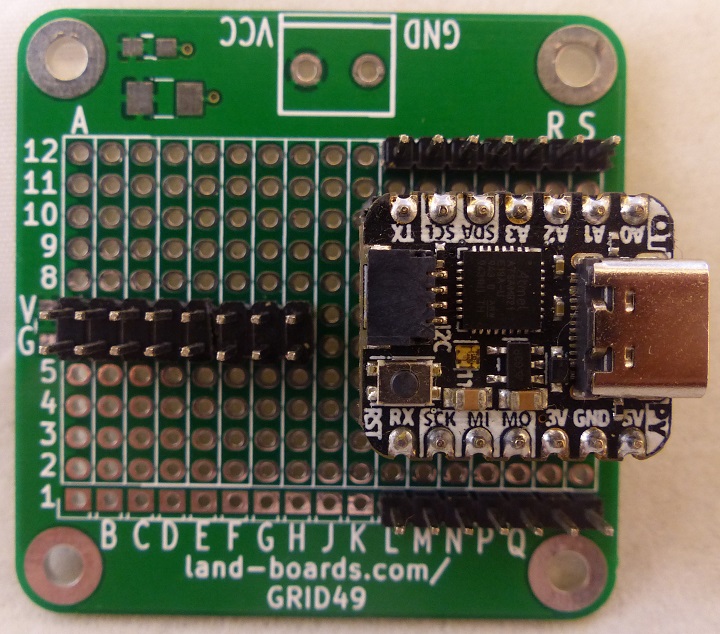
QTPy49 Card
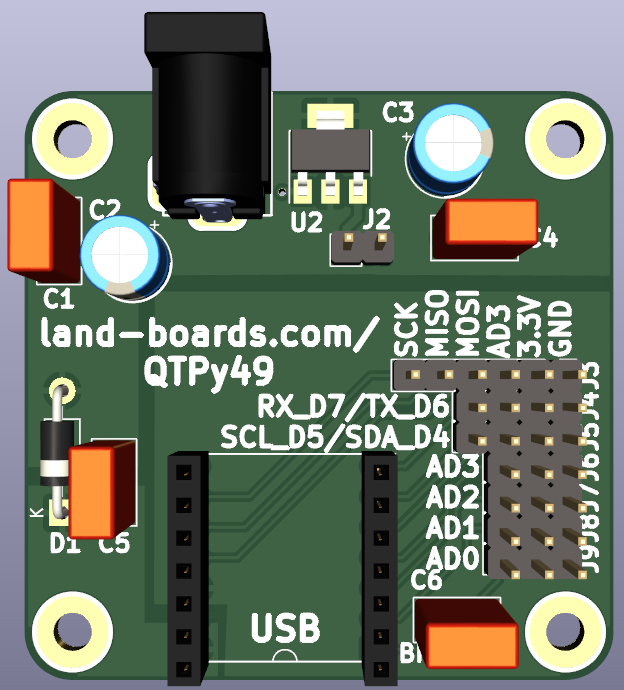
SD CARD X49
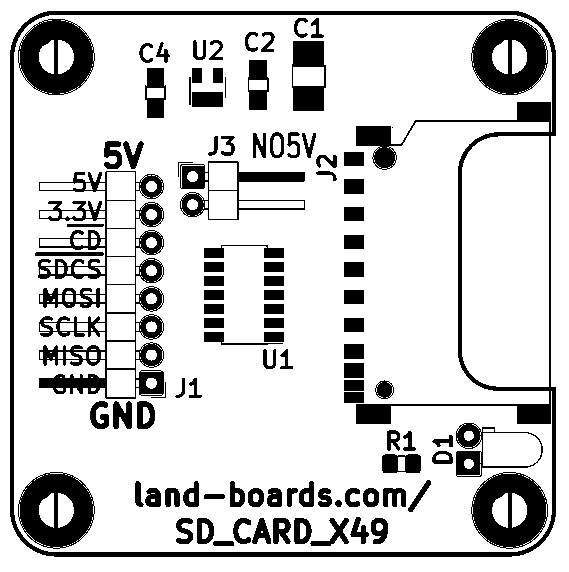

RS-232 Level Shifter (Optional)
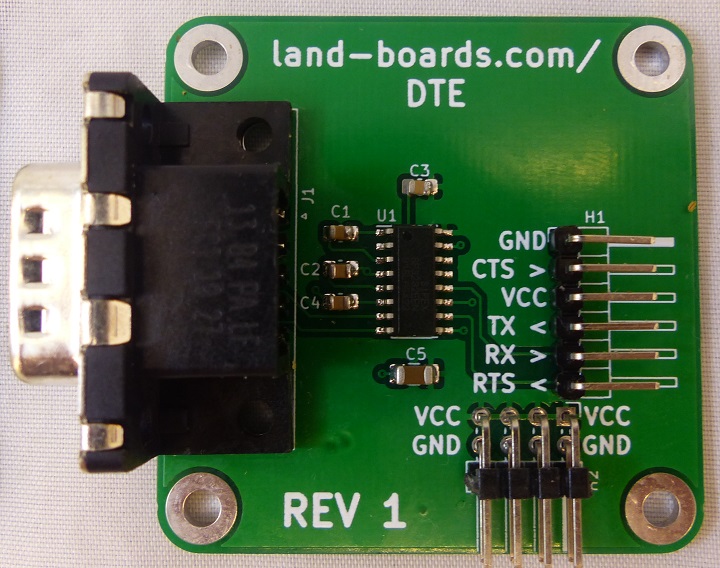
Level Shifter (Optional)
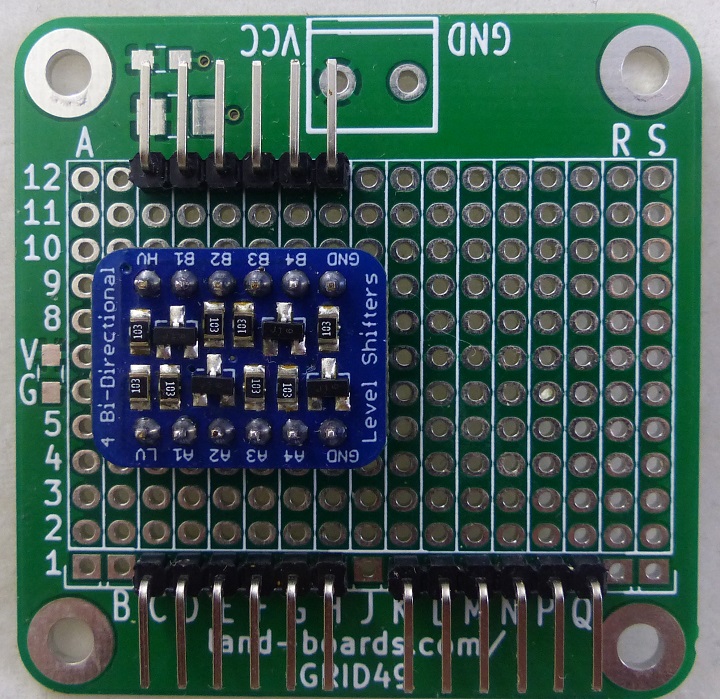
QT Py Breakout Card (on GRID49 card) Cabling
- QT Py uses (2) 1x7 male headers for signals
- Cut off 1 set of holes of (2) female housings to make 1x7 female headers
- SD Card uses (1) 1x8 header
- MyMenu uses (1) 1x5 header
- QT Py uses 2x8 header for 3.3V and Ground
- 40mm cables to Host Target
| QT Py
|
SIGNAL
|
MyMenu
|
COLOR
|
| 1 (A0)
|
INT(D6)
|
P2-5
|
GRY
|
| 5 (SDA)
|
SDA
|
P2-3
|
WHT
|
| 6 (SCL)
|
SCL
|
P2-4
|
BRN
|
| GND
|
GND
|
P2-1
|
BLK
|
| VCC
|
+3.3V
|
P2-2
|
RED
|
QT Py Breakout Card to SD_CARD_X49 Cabling
| QT Py
|
SIGNAL
|
SD_CARD_X49
|
COLOR
|
| 03 (A3)
|
SS*
|
J1-5
|
GRY
|
| 09 (SCK)
|
SCK
|
J1-3
|
BLU
|
| 10 (MI)
|
MISO
|
J1-2
|
BRN
|
| 11 (MO)
|
MOSI
|
J1-4
|
WHT
|
| GND
|
GND
|
J1-1
|
BLK
|
| VCC
|
3.3V
|
J1-8
|
RED
|
QT Py Breakout Card to Host Serial
| QT Py
|
SIGNAL
|
COLOR
|
| GND
|
GND
|
BLK
|
| 7 (TX)
|
TX
|
WHT
|
| 8 (RX)
|
RX
|
BRN
|
| 2 (A1)
|
RTS*
|
GRY
|
| 3 (A2)
|
CTS*
|
ORA
|
QTPy49 Card Cabling
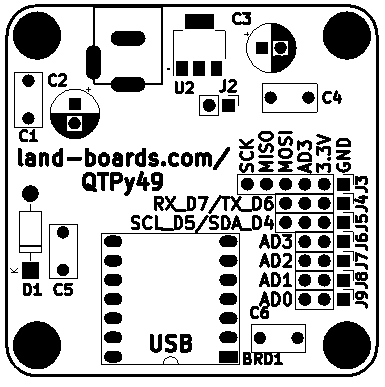
- QT Py Card has function specific headers
| QTPy49
|
SIGNAL
|
MyMenu
|
COLOR
|
| J5-1
|
GND
|
P2-1
|
BLK
|
| J5-2
|
+3.3V
|
P2-2
|
RED
|
| J5-3
|
SDA
|
P2-3
|
WHT
|
| J5-4
|
SCL
|
P2-4
|
BRN
|
| J9-3
|
INT(AD0)
|
P2-5
|
GRY
|
QTPy49 Card to SD_CARD_X49 Cabling
| QT Py
|
SIGNAL
|
SD_CARD_X49
|
COLOR
|
| J3-1
|
GND
|
J1-1
|
BLK
|
| J3-2
|
3.3V
|
J1-8
|
RED
|
| J3-4 (MO)
|
MOSI
|
J1-4
|
WHT
|
| J3-5 (MI)
|
MISO
|
J1-2
|
BRN
|
| J3-6 (SCK)
|
SCK
|
J1-3
|
BLU
|
| J6-3 (A3)
|
SS*
|
J1-5
|
GRY
|
QTPy49 Card to Host Serial
| QTPy49
|
SIGNAL
|
COLOR
|
| J8-3 (AD1)
|
RTS*
|
GRY
|
| J7-1 (AD2)
|
CTS*
|
ORA
|
| J4-4 (RX)
|
RX
|
BRN
|
| J4-3 (TX)
|
TX
|
WHT
|
| J4-2 (VCC)
|
+3.3V
|
Xlator (only)
|
| J4-1 (GND)
|
GND
|
BLK
|
Software
- Developed using Arduino IDE V1.8.xx
- Arduino IDE Setup for QT Py
- Requires Arduino IDE version 1.8 or higher
- Add to Preferences Additional Boards Manager URLs
https://adafruit.github.io/arduino-board-index/package_adafruit_index.json
pinMode(pin, INPUT_PULLUP)
#if defined(ARDUINO_SAMD_ZERO) && defined(SERIAL_PORT_USBVIRTUAL)
// Required for Serial on Zero based boards
#define Serial SERIAL_PORT_USBVIRTUAL
#endif
const char str[] = "My very long string";
Human Interface Design (HID)
SD Card
SD Card Library
- SD Card library
- The SD library allows for reading from and writing to SD cards, e.g. on the Arduino Ethernet Shield
- Based on sdfatlib
- The library supports FAT16 and FAT32 file systems on standard SD cards and SDHC cards
- It uses short 8.3 names for files
- The file names passed to the SD library functions can include paths separated by forward-slashes, /, e.g. “directory/filename.txt”
- Because the working directory is always the root of the SD card, a name refers to the same file whether or not it includes a leading slash (e.g. “/file.txt” is equivalent to “file.txt”)
- As of version 1.0, the library supports opening multiple files.
- The communication between the microcontroller and the SD card uses SPI, which takes place on digital pins 11, 12, and 13 (on most Arduino boards) or 50, 51, and 52 (Arduino Mega)
- Additionally, another pin must be used to select the SD card
- This can be the hardware SS pin - pin 10 (on most Arduino boards) or pin 53 (on the Mega) - or another pin specified in the call to SD.begin()
SD Card Example Code
SD Card Connections
** SCLK - CLK - pin 13
** MISO - SDI - pin 12
** MOSI - SDO - pin 11
** SS - CS - depends on your SD card shield or module.
Serial
- Serial Reference
- Serial.begin(speed)
- Serial.available()
- Get the number of bytes (characters) available for reading from the serial port.
- This is data that’s already arrived and stored in the serial receive buffer (which holds 64 bytes).
- Turn off/on receive handshake based on Serial.available() count and storage
- Serial.write()
- Writes binary data to the serial port
- This data is sent as a byte or series of bytes
- To send the characters representing the digits of a number use the print() function instead.
- Syntax
Serial.write(val)
Serial.write(str)
Serial.write(buf, len)
References






